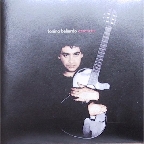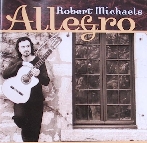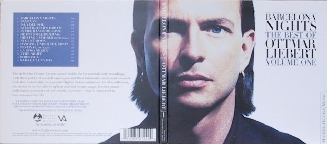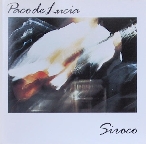fused, not diluted
They say flamenco was brought to Andalusia (southern Spain) by the Gypsies as a consequence of their migration from India in the 12th--14th centuries. Some say the modality owes just as much to Arab culture, especially the Moors of North Africa who occupied Spain for 500 years until their expulsion in the 15th Century. While that semi-tone wail reminds us of mosques and funerals, it can also be an overture to sexual engagement. The song is a keening and the rhythm is imitative: the bullfighter's dance, the horseman's canter, the goat herder's shuffle, the water wheel's hiccup, etc.
 Two recent examples of this
Afro-Andalusian fusion style are "Desert Chase" by Montreal guitarist Robert
Michaels and "Caravan Road" by Tonino Baliardo, guitarist of the well-known
Paris ensemble, The Gypsy Kings. Baliardo is the real thing, of course, born of
a gypsy family in Montpelier. His recent solo CD Essences is impressive
for its technical fluency and avant fusion repertoire. Jazz flamenco (with a
nod to John Coltrane), dance (rumba, bossa nova), lyricism... although it must
be said that lyricism isn't really Baliardo's thing. He's a bit of a punk
player -- masculine, aggressive, urgent... like a slave driver.
Two recent examples of this
Afro-Andalusian fusion style are "Desert Chase" by Montreal guitarist Robert
Michaels and "Caravan Road" by Tonino Baliardo, guitarist of the well-known
Paris ensemble, The Gypsy Kings. Baliardo is the real thing, of course, born of
a gypsy family in Montpelier. His recent solo CD Essences is impressive
for its technical fluency and avant fusion repertoire. Jazz flamenco (with a
nod to John Coltrane), dance (rumba, bossa nova), lyricism... although it must
be said that lyricism isn't really Baliardo's thing. He's a bit of a punk
player -- masculine, aggressive, urgent... like a slave driver.
Maybe this is why "Caravan Road" is the most striking number. The percussive hustle is both threatening and exhilarating, as if you're being pursued by a stampeding herd in the Sahara. The bottom end is driven by the thudding elephantine bass of Gerard Prevost and the wild hooves of Nicholas Montazaud and Rabah Khalfa on percussion. Yet while the rhythm is ancient and primitive, there's a modern feel to the piece, perhaps due to those opening ninths, those "the train is comin" chords that even country players love. Still, the real country here is the Maghreb, represented by the chatter of the derbuka and the nasal, Islamic cries of the vocal. Turn up the stereo, lie down on the floor, get trampled -- you'll love it.
Still in the desert, imagine yourself riding a fine Arabian stallion, chasing a fugitive... another rider, a woman perhaps. Or if you're a woman, pursued by a handsome Bedouin and his falcon. This is the ambience of Robert Michaels' "Desert Chase". The exciting percussion, the middle-eastern riffing, the wailing in the wind, the running melody of the guitar... a steady gallop into dream. Michaels' playing is superb, laced with stunning speed runs and lyrical interludes. This is musical onomatopoeia at its best. Make no mistake: flamenco guitar is for virtuosos.
 Naturally, if you're not an
Andalusian gypsy, any flamenco you play is bound to be fusion. Michaels has
drifted around the Latin world, soaking up the influences. His most recent CD,
Allegro, is all fusion, all
flamenco nuevo. Like Ottmar Liebert, he isn't afraid to include versions
of the popular music he grew up with, i.e. "Riders On The Storm" by The Doors
or -- even more improbably -- the Phil Collins classic "In The Air Tonight"
(great vocal by Shelley Hamilton), that mystical solea once featured in
Miami Vice. It's good stuff, makes Michaels' music very accessible... but, a
Canadian flamenco player?
Naturally, if you're not an
Andalusian gypsy, any flamenco you play is bound to be fusion. Michaels has
drifted around the Latin world, soaking up the influences. His most recent CD,
Allegro, is all fusion, all
flamenco nuevo. Like Ottmar Liebert, he isn't afraid to include versions
of the popular music he grew up with, i.e. "Riders On The Storm" by The Doors
or -- even more improbably -- the Phil Collins classic "In The Air Tonight"
(great vocal by Shelley Hamilton), that mystical solea once featured in
Miami Vice. It's good stuff, makes Michaels' music very accessible... but, a
Canadian flamenco player?
He's not alone. Oscar Lopez, born in Chile, works out of Calgary. Check out his CD Armando's Fire for some kick-ass fusion playing. Who can resist titles such as the New Age "Walking Through The Pyramid" or the ambiguous "Latino"?
the bavarian mariachi
In the cult movie El Mariachi you first see the young guitar player trying to hitch a ride on the highway outside of Acuna, Mexico. His interior voice says, "It was a morning like any other... no love... no luck... no ride. Nothing changes. I came across a turtle on the highway... we were both taking our time getting to where we were going...."
Not so Ottmar Liebert, a German emigre to the USA who is, for many listeners, the most complete definition of the flamenco revival. Why? Because his style is feminine, lyrical, nostalgic? Or because his first CD -- an indie release in 1990 -- is called Nouveau Flamenco? While OL has a classical guitar background, his influences include not only the Regatta de Blanc verve of the punk new wave of the late seventies/early eighties but also pop music in general. OL is not the sort of player who misses notes. His fabulous technical ability combines with an uncanny compositional intuition to create strong, original material. His touch is light, melodic, and fits the "easy listening" ambience of the New Age genre. You feel nostalgic when you listen to his first instrumental "hit", "Sante Fe", think immediately of the Old West, movie theme music, waggon wheels echoing in the arroyos, riders in the sage, ghost gunfighters and banditos. This cross-border vibe permeates much of his music... so, just as Andalusia blends with North Africa, so too the American south-west with Mexico.
One of OL's best hybrid compositions is "Snakecharmer", which can be found on his CD, rumba collection: 1992--1997 and on the recent DVD release, Wide-Eyed + Dreaming, which features 10 instrumentals from a concert at the Calgary Centre for the Performing Arts [framed by interviews with the man at his home and nearby environs in New Mexico]. Heresy to purists, the live version of "Snakecharmer" starts with a prelude played on the electric guitar, a deep canyon sound filled with metaphors of spirits, petroglyphs, water falling... you are the snake, and you hear the sound of the guitar calling. Again, the feeling is one of big skies, and an open landscape where you can see for a hundred miles. When OL reverts to his Spanish acoustic to complete the tune, his ability as a great rhythm player is also evident. He never overplays -- in this sense his discipline is his secret. Certainly, he can spill the notes out with great speed... but it's by his minimalism that beauty is created. Notes hang, chords ghost... and you imagine the rest.
His fascination with the crawling snake is explored once again in "Yarrow: Snaky Desert Song" (Little Wing, Epic 2001)... a beautiful piece... but is it flamenco?
"I think of the landscape (New Mexico) as an empty canvas," says OL in one of the DVD sequences. Hence his music is anthropomorphic, bordered with the silence of a large space. Behind the catchy melodies the landscape is hallucinatory.
His band luna negra is what fusion is all about... you might think they're a retro-looking bunch, a lost commune... but that's New Age karma. They certainly lay down a tight rhythm: the flowing fretless runs of Jon Gagan on bass, the layered syncopations of Mark Clark ... occasionally Ron Wagner on Tablas, Dumbek, various ancient skins... although it must be noted that bassist Gagan is the only continuous member and these days Mike Chavez is playing drums. Sometimes OL uses a second guitarist, even horns... and of course he has no purist aversion to the synthesizer. While he might play the acoustic with nylon strings, it's wired to a sampler which triggers occasional soft synth orchestral backgrounds.

Barcelona Nights: the best of Ottmar Liebert, Vol 1 (Higher Octave Music, 2001). A good introduction to the soft hands of the New Age maestro. All of the recordings are excellent, even the bodega cellar reverb tracks. "Barcelona Nights", the oft anthologized "Sante Fe", the dreamy "Isla del Sol", the strange heaving blood dance of "Bullfighter's Dream", the avant "Borrasca"... and more. Nice box and labelling too.
the rumba collection: 1992--1997 (Sony Music, 1997). Very nice, good sunny morning music, or early evening on the patio with a bottle of Chilean Merlot... or a bogart, if you still do that sort of thing. A couple of tracks with tasty electric guitar codas, others, horns. "Butterfly + Juniper" is especially good. Rumbas, sambas, bossa novas... occasional tango preludes, Mex mariachi licks... and lots of the engaging OL rhythm playing.
Nouveau Flamenco (Higher Octave Music, 2000) Tenth Anniversary reissue of the indie CD that propelled OL to fame. Nice to have. Sets out his fusion style of disciplined structures and improv sidebars.
meanwhile, back in Andalusia...
 One of the more unusual
artists working in the new flamenco is Chano Dominguez, a Spanish jazz
pianist from Cadiz. His fusion is more multi-media, more complete in terms of
what flamenco is about. The piano replaces the guitar (el toque), and he uses
the other two elements, song (el cante) and dance (el baile). If you like the
idea of, say, Dave Brubeck playing a flamenco buleria with a sextet --
keys, drums, bass... plus a gypsy trio who sing, dance and drum -- then check
out Chano. Here you have jazz scaling with flamenco rhythm. "Flamenco floats,"
says Chano. "It has rhythms called the coming and the going...." He has
a great cameo in Calle 54, the recent DVD on Latin Jazz by Fernando
Trubea. [Included with this DVD is a highly informative documentary about the
emergence of jazz latino, its origins in the rhythms of Santeria
(Nigeria) and Palo (Congo) via Cuba and the rest of South America].
One of the more unusual
artists working in the new flamenco is Chano Dominguez, a Spanish jazz
pianist from Cadiz. His fusion is more multi-media, more complete in terms of
what flamenco is about. The piano replaces the guitar (el toque), and he uses
the other two elements, song (el cante) and dance (el baile). If you like the
idea of, say, Dave Brubeck playing a flamenco buleria with a sextet --
keys, drums, bass... plus a gypsy trio who sing, dance and drum -- then check
out Chano. Here you have jazz scaling with flamenco rhythm. "Flamenco floats,"
says Chano. "It has rhythms called the coming and the going...." He has
a great cameo in Calle 54, the recent DVD on Latin Jazz by Fernando
Trubea. [Included with this DVD is a highly informative documentary about the
emergence of jazz latino, its origins in the rhythms of Santeria
(Nigeria) and Palo (Congo) via Cuba and the rest of South America].
Intellectual, yes... populist, no. But what about Paco de Lucia, whom Chano credits as the first flamenco player to exercise jazz fusion? de Lucia's playing is brilliant and pure, absolutely authentic, yet extremely advanced in terms of its melodic and rhythmic shifting. His collaborations with guitar icons John McLaughlin and Al di Meola are legendary and influential. Here, the album Castro Marin is pivotal. Recorded in Japan in the last week of December, 1980, the last three tracks feature de Lucia facing off with Larry Coryell and John McLaughlin. The mystical "Palenque" is built around a classic McLaughlin riff, extremely inferential, evoking images of history, Mayan ruins and the "sport" of cock fighting. This is deep stuff. The virtuosity is intimidating, despite the fact that the Mahavishnu McLaughlin says "flamenco is just two chords" [not sure if he means the fundamental plus a raised chord, i.e. E minor/F or what]... the tonal colorations here are excellent.
Al di Meola has to be mentioned, as he was the first to play with de Lucia, spontaneously producing "Mediterranean Sundance" [not to be confused with Stevie Ray Vaughan's Riviera Sunrise], included on his album Elegant Gypsy (1977). Perhaps you've seen Paco, Al and the Mahavishnu perform this instrumental as a guitar trio on the video of Pavoritti & friends war child benefit concert. Perhaps you were unimpressed. Perhaps you dismissed them as a bunch of elegant doodlers. Too hung up on speed, too cerebral.
 At times the new flamenco certainly seems
to be just that. The acoustic guitar is by nature vertical, where many notes
are needed to fill space because of its low sustain in the normal acoustic
environment. But... some guys play outside the liquor store, Paco de Lucia
plays inside the royal court. All you have to do is listen to his 1987
compilation, Siroco. Here the maestro (and he is the maestro)
gives the listener a lesson in the main moods of flamenco, from the tango to
the solea. Some consider Siroco the best recording of pure flamenco with
a contemporary edge ever made.
At times the new flamenco certainly seems
to be just that. The acoustic guitar is by nature vertical, where many notes
are needed to fill space because of its low sustain in the normal acoustic
environment. But... some guys play outside the liquor store, Paco de Lucia
plays inside the royal court. All you have to do is listen to his 1987
compilation, Siroco. Here the maestro (and he is the maestro)
gives the listener a lesson in the main moods of flamenco, from the tango to
the solea. Some consider Siroco the best recording of pure flamenco with
a contemporary edge ever made.
No wonder Paco can afford to have a hideaway villa near Cancun....
Paco de Lucia & sextet: Live in America (Polygram, 1993). If nothing else, listen to this CD. The Gypsy Kings are peasants compared to this group. What can be said? "In flamenco," says Paco, "it is the guitar that has developed, and today there are many great guitarists." Amen.
© LR 5/02
*Of related interest:
www.flamencomania.com
www.vicente-amigo.com/Ingles/paginasasp/Index.asp